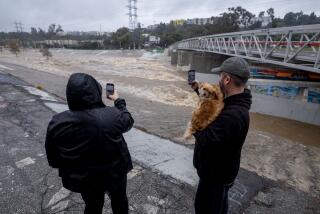Is Syria conflict a case study for climate change?

Science just served up a double coupon for the argumentative: A new study suggests that climate change is driving a Middle East conflict that brought the Islamic State to prominence.
Climate change contributed to the severity of a record-setting drought that led to agricultural collapse in Syria’s breadbasket region, pushing rural residents into crowded cities where the 2011 uprising against President Bashar Assad began, according to a study published this week in the journal Proceedings of the National Academy of Sciences.
This doesn’t mean that climate change caused the conflict, which has many complex roots -- but it did make Syria more vulnerable to uprising, the study concluded.
“All of these things happened right before the uprising, so it’s reasonable to assume that these were contributing factors,” said study coauthor Colin Kelley, a geographer at UC Santa Barbara. “But it’s difficult to quantify any one of these things, much less to quantify relative importance of all these factors in contributing to Syria’s unrest.”
The Pentagon has long considered climate change to be a “threat multiplier” in many regions of the world, and numerous studies have linked armed conflict to shifts in climate throughout history. But few have found correlations between current conflicts and the rise in carbon dioxide in Earth’s atmosphere, driven by burning of fossil fuels.
“It’s the first scientific paper to make the case that human-caused climate change is already altering the risk of large-scale social unrest and violence,” said Solomon Hsiang, a UC Berkeley public policy expert who has studied data linking climate and conflict.
“It is important to keep in mind that it is the additional risk of conflict that we caused through climate change,” Hsiang added. “Even in the absence of climate change, the ‘natural’ drought event may have been enough to spark violence, so we probably don’t want to attribute the entire conflict just to the portion of the drought caused by humans.”
Syria’s latitude and position at the eastern edge of the Mediterranean made it somewhat easier to discern the usually faint signal of man-made climate change within the natural variability of climate cycles, said Kelley, who conducted the research while at Columbia University’s Lamont-Doherty Earth Observatory.
Natural variability in the region, which has always been prone to dry spells, could not explain the depth and extent of the drought, the study found. But it was “two to three times more likely that you can have a drought this severe” when researchers factored in the effects of both natural cycles and the “forcing” of additional carbon dioxide being pumped into the atmosphere in modern industrial times.
The three-year drought began in the early winter of 2006, and combined with poor water management and economic policies, led to the displacement of 1.5 million people from rural regions to Syria’s crowded western cities, according to the study.
NASA satellite imagery shows that Syria’s groundwater sharply declined, leaving it with diminished options to mitigate the effects of decreased rain, according to the study. By 2008, agriculture’s contribution to gross domestic product decreased to 17% from 25% just five years before, as Syria went from being a net exporter of wheat to an importer of the grain, the study showed.
The drought also came on the heels of a previous deep dry spell in the late 1990s -- seven of 11 years with rainfall below the 20th century average occurred from 1998 to 2009.
Some studies have predicted that the so-called fertile crescent extending from Turkey through Iraq will shrivel up by the end of this century as carbon emissions continue to increase and global temperatures rise apace.
A study published last week showed that Earth’s most important atmospheric circulation belt has been substantially altered, creating persistent areas of lower precipitation in mid-latitudes that match current drought zones. One of them stretches across the Mediterranean and through the fertile crescent.
Follow me on Twitter: @LATsciguy







